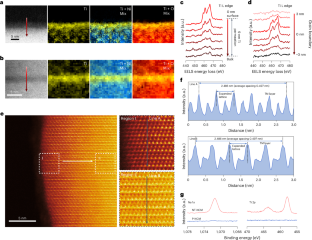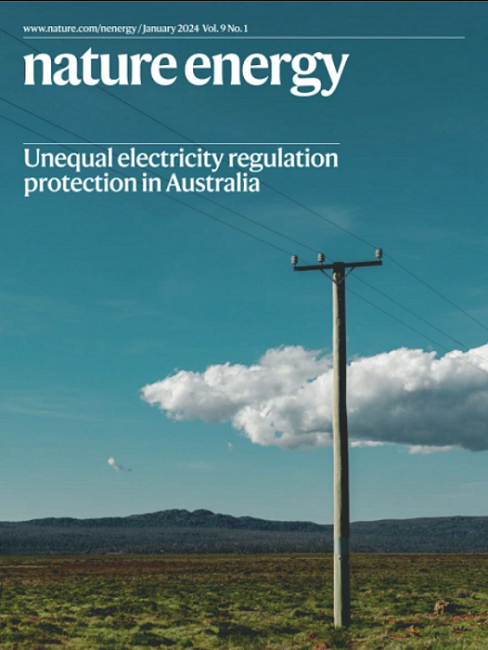Exceptional layered cathode stability at 4.8 V via supersaturated high-valence cation design
IF 60.1
1区 材料科学
Q1 ENERGY & FUELS
引用次数: 0
Abstract
High-energy-density lithium-ion batteries for extreme conditions require cathodes that remain stable under harsh operation, including ultrahigh cutoff voltage and extreme temperatures. For Ni-rich layered cathodes, raising the charge voltage from 4.3 V to 4.8 V (versus Li+/Li) increases the energy density, yet this sacrifices cycling stability and remains challenging. Here we report a dopant-pairing method that achieves highly enriched Ti4+ (~9-nm surface layer) in LiNi0.8Co0.1Mn0.1O2 facilitated by Na+, enabling significantly enhanced high-voltage cyclability. Such high surface Ti4+ concentrations are unattainable without pairing Na+, representing a form of supersaturation within the layered cathode matrix. The enhanced stability is linked to improved structural integrity and reduced cathode–electrolyte side reactions (for example, O2 and CO2 evolution). In addition, ion transport is better preserved even after prolonged cycling at 4.8 V. This work highlights the power of supersaturated high-valence d0 cation Mz+ (z ≥ 4) in modifying the cathode–electrolyte interactions and degradation pathway. Ni-rich layered cathodes promise higher energy density at high voltages, but suffer from poor cycling stability. This study improves stability by introducing a supersaturated high-valence cation surface layer that stabilizes the structure and suppresses side reactions for durable cycling at 4.8 V.


通过过饱和高价阳离子设计,在4.8 V下具有优异的层状阴极稳定性
极端条件下的高能量密度锂离子电池要求阴极在恶劣操作下保持稳定,包括超高截止电压和极端温度。对于富镍层状阴极,将充电电压从4.3 V提高到4.8 V(相对于Li+/Li)会增加能量密度,但这会牺牲循环稳定性,并且仍然具有挑战性。在这里,我们报道了一种掺杂剂配对方法,在Na+的促进下,在LiNi0.8Co0.1Mn0.1O2中实现了高富集Ti4+ (~9 nm表层),从而显著增强了高压可循环性。如此高的表面Ti4+浓度是不可能在没有配对Na+的情况下实现的,这代表了层状阴极基质内的一种过饱和形式。稳定性的增强与结构完整性的改善和阴极电解质副反应的减少(例如,O2和CO2的释放)有关。此外,即使在4.8 V下长时间循环,离子输运也能得到更好的保存。这项工作强调了过饱和高价阳离子Mz+ (z≥4)在改变阴极-电解质相互作用和降解途径方面的力量。
本文章由计算机程序翻译,如有差异,请以英文原文为准。
求助全文
约1分钟内获得全文
求助全文
来源期刊

Nature Energy
Energy-Energy Engineering and Power Technology
CiteScore
75.10
自引率
1.10%
发文量
193
期刊介绍:
Nature Energy is a monthly, online-only journal committed to showcasing the most impactful research on energy, covering everything from its generation and distribution to the societal implications of energy technologies and policies.
With a focus on exploring all facets of the ongoing energy discourse, Nature Energy delves into topics such as energy generation, storage, distribution, management, and the societal impacts of energy technologies and policies. Emphasizing studies that push the boundaries of knowledge and contribute to the development of next-generation solutions, the journal serves as a platform for the exchange of ideas among stakeholders at the forefront of the energy sector.
Maintaining the hallmark standards of the Nature brand, Nature Energy boasts a dedicated team of professional editors, a rigorous peer-review process, meticulous copy-editing and production, rapid publication times, and editorial independence.
In addition to original research articles, Nature Energy also publishes a range of content types, including Comments, Perspectives, Reviews, News & Views, Features, and Correspondence, covering a diverse array of disciplines relevant to the field of energy.
 求助内容:
求助内容: 应助结果提醒方式:
应助结果提醒方式:


